Content
Micky Mouse

EM 000872978
Of mice and men and money
100 years of Disney
In the beginning was the mouse? No, in the beginning there was Oswald. And Alice. Walter "Walt" Elias Disney (1901-1966) began the path to becoming one of the world's largest media companies with short films like "Alice in Cartoonland". His first mini-studio, founded in 1920 in Kansas City, was called "Laugh-O-Gram". It did not last long. Disney tried a new start in California - in his uncle's garage, with his brother Roy's money. At some point, the cinema distributor M.J. Winkler became interested in his Alice cartoons and signed a contract with the brothers on 16 October 1923, which is now considered the birth certificate of the Disney corporation.
The first successes with Alice were followed by "Oswald the lucky rabbit" as a new cartoon star. The young company grew with him, but when Walt fell out with Winkler, he lost the rights to the character. As a successor, Disney conceived a creature that looked quite similar to Oswald, but was supposed to be a mouse. Disney wanted to christen it "Mortimer the mouse", but his wife thought "Mickey" was more snappy. The first short film with the mouse, "Plane Crazy", premiered on 15 May 1928. The rest is history...
In September 1951, the number one edition of "Micky Maus Magazin“appeared in Germany. The first real comic magazine on the black-and-white dominated (West) German print magazine market hit like a colourful bomb.
Post-war educated Germans, whose understanding of art was still clouded by the proverbial "mustiness of a thousand years", reviled the bubble stories as "trash" or sneered at them as cultureless American scribblings. But this could not stop the triumph of comics in the country of the picture story pioneer Wilhelm Busch.
What was new was the content, but also the colour: the comic was produced in four-colour printing. The "colourful monthly" was correspondingly expensive: it cost 75 pfennigs - roughly an average hourly wage at the time. Nevertheless, around 130,000 copies of the first issue were sold. The range must have been many times that, because the magazines were passed on among friends as coveted objects. The circulation soon rose to 400,00. The publication frequency was accelerated to fortnightly at first, and later to weekly. It remained that way for almost 60 years.
Germany was late to the party: in Italy, France and Great Britain, magazines with Walt Disney's characters had already appeared in the 1930s. But Nazi rule and the war delayed the start of comic culture in Germany. That was also the reason why the magazine was named after the mouse, who featured much less in it than the real star, Donald Duck. Hardly anyone in this country knew the drake at that time, while elsewhere he had long since outstripped Mickey. The mouse and the duck then paved the way for the first German comics like "Fix und Foxi" or "Sigurd".
Frau Fuchs' phenomenal fondness for verse
The first editor-in-chief of "Micky Maus Magazin“ was the art historian Dr. Erika Fuchs. As a translator of the US comics, she raised their language to a snappy literary level. Legendary are her enthusiasm for creative alliterations, her hidden quotations from classics and, above all, her onomatopoetic neologism of shortening verbs to the root of the word in order to represent sounds and feelings: Brood! Moan! Swallow! Clink! Crunch! Groan! Sigh! This new "Inflectiv" in German was later called "Erikativ" in her honour.
Fuchs (1906-2005) made an invaluable contribution to the enrichment of the German language and the establishment of comics as a form of pop culture in Germany. This is why the editor-in-chief of the comic, once reviled as a "trashy magazine", now has her own ![]() museum (in Schwarzenbach an der Saale) and why, for example, the feature section of the "FAZ" is firmly in the hands of Fuchs admirers.
museum (in Schwarzenbach an der Saale) and why, for example, the feature section of the "FAZ" is firmly in the hands of Fuchs admirers.
The Micky Maus magazine, which Fuchs ran until 1988, temporarily reached record circulations of one million copies after the German reunification. After a rapid decline since the turn of the millennium, it has now settled down to a print run of about 70,000 issues and is now published only fortnightly, but more often with a "gimmick" (DE word mark 954028), an idea of the original rival paper "Yps", which Ehapa has since taken over. However, Ehapa also publishes a whole series of other publications with Disney characters, some of which achieve even higher circulations, such as the "Lustige Taschenbücher" or the special editions with stories by the great cartoonist Carl Barks.

Minnie Mouse trade mark (EM018144474)
By that time, Mickey Mouse (396494501 DE) was already the world's best-known comic figure. Although the premiere of the film "Steamboat Willie" on November 18, 1928 is often assumed to be the date of birth of the mouse, it actually had its screen debut on May 15 of the same year in the cartoon „![]() Plane Crazy“.
Plane Crazy“.
In it, the mouse imitates the pilot Charles Lindbergh, who was the first to cross the Atlantic alone. Already at Mickey's side was girlfriend Minnie Mouse (IR 151050). However, this wonderfully chaotic little film was only shown once as a silent film during a test screening and was initially not distributed. Only after the success of "Steamboat Willie" did "Plane Crazy" return to the cinemas a year later with a soundtrack, this time with success.
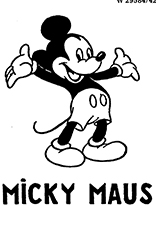
The German Micky Maus trade mark (1008802 DE)
Success - that is the star under which the anthropomorphic mouse was born. Today it is the trademark of one of the world's largest entertainment companies with annual sales of around 78 billion Euros (2022). But no one could have foreseen this success story in 1928.
The mouse once was a rabbit

Longer ears, shorter nose: Mickey´s predecessor Oswald (No. 30621169)
The mouse began her career very modestly, as a substitute, so to speak. Until then, Walt Disney's first "star" had been a character called "Oswald the lucky Rabbit" 306211696 DE, a bunny Mickey looked very much like. Disney lost the rights to this character to its partner Universal Pictures after a dispute over production costs. Disney then developed the first Mickey Mouse cartoons together with his employee Ub Iwerks, while Universal released further Oswald films. Today, the Oswald trade mark rights are owned by Disney again.
In the beginning there was the mouse
Originally the mouse was supposed to be called "Mortimer", but Disney's wife allegedly found this name too conservative; she is said to have suggested "Mickey". Walt Disney not only gave Mickey his voice in the first talkies himself, he also invested all of his money (which wasn´t that much, back then) in the career of his mouse.
The enormous success, which quickly set in, proved him right. He not only proved a lucky hand artistically, but also showed his entrepreneurial qualities by securing his creations with industrial property rights and then being one of the first to merchandise on a large scale. The first licensed product to adorn the mouse appeared as early as 1930. And his company continues to pursue this profitable strategy to this day with the utmost perfection.
Milking the mouse
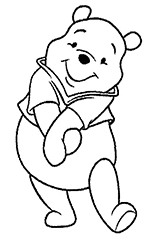
A well-known "bear of very little brain" in Disney´s version
Some 1165 Disney trademarks are currently (Oct 2023) registered at the DPMA database DPMAregister After Mickey Mouse, Disney developed many more popular cartoon characters, all of which he secured with all industrial property rights. Of course, the international markets were also kept in mind and the respective national names of the figures such as „Micky Maus“ or, for example, "Dippy" or "Bucefalo" were also secured for Goofy as a brand.
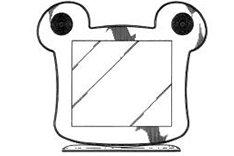
The screens have ears (No. 000287578_0003_1)
In addition, Disney secured its most popular characters as a word-figurative trademark, such as Bambi , Peter Pan, Arielle or the silhouette of Mary Poppins.
And the mouse was milked over and over again: Disney registered designs for televisions and computer screens with mouse ears (000287578_0003_1) or - particularly ingenious - for a computer mouse in Mickey style.
Cartoon pioneer with a well thought-out patent Policy
Disney was not only a pioneer of merchandising, his company also made decisive advances in film technology, especially in its early years. Numerous patent applications such as "Method for synchronizing photoplays" ( ![]() US1941341A) or "Method of creating cartoon effects" (
US1941341A) or "Method of creating cartoon effects" ( ![]() US2260092A) in the 1930s bear witness to how the company tinkered with ever more successful animated films and promoted the "Art of Animation" (
US2260092A) in the 1930s bear witness to how the company tinkered with ever more successful animated films and promoted the "Art of Animation" ( ![]() US2201689A, 1936).
US2201689A, 1936).
Technical perfection is still a hallmark of the multimedia company's films, which continues to file new patents such as "Variable Resolution recognition"( ![]() US020210019509A1 (1,38 MB)) or "Blockchain configuration" (
US020210019509A1 (1,38 MB)) or "Blockchain configuration" ( ![]() US020210218550A1). Disney's recent patent applications often revolve around streaming or downloading (e.g.
US020210218550A1). Disney's recent patent applications often revolve around streaming or downloading (e.g. ![]() US11757895B2 (1,32 MB),
US11757895B2 (1,32 MB), ![]() US11765360B2 (1,39 MB)).
US11765360B2 (1,39 MB)).
Disney also secured its market position by acquiring creative competitors such as Pixar together with their patents (e.g. "Statistical hair scattering model", ![]() US9905045B1 (1,57 MB) or most recently "Contour lines for volumetric objects",
US9905045B1 (1,57 MB) or most recently "Contour lines for volumetric objects", ![]() US11727616B2 (1,79 MB)) or by buying the "Star Wars" studio Lucasfilm.
US11727616B2 (1,79 MB)) or by buying the "Star Wars" studio Lucasfilm.
The mouse becomes tame, the duck becomes human
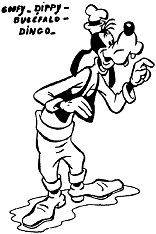
182053 DE
Mickey Mouse quickly changed not only visually (she left her predecessor Oswald clearly behind) but also in character after the first films. While in the early films the mouse was still a cheeky, daredevil guy with sometimes boorish behaviour, she now became tamer, smoother and almost boring.
The "wild" characteristics were adopted by her in-house competitor Donald Duck (1008801 DE), whose popularity soon took over despite - or precisely because of - his coarseness of the mouse.
Although Micky Mouse tried to make some "image changes" over time, he often seemed colourless and boring compared to the very "human" Donald in the countless comic books that have appeared since the 1940s and that have become the main medium. Nevertheless, after almost 100 years, the mouse´s fame is almost universal.
Text: Dr. Jan Björn Potthast; Pictures: DPMAregister, Egmont Ehapa Verlag, DEPATISnet
Last updated: 10 December 2025

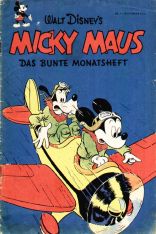
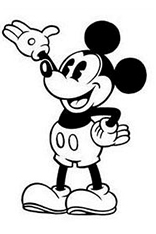
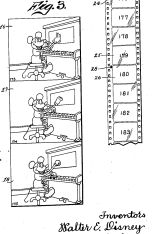
Not only protecting innovations
Social Media